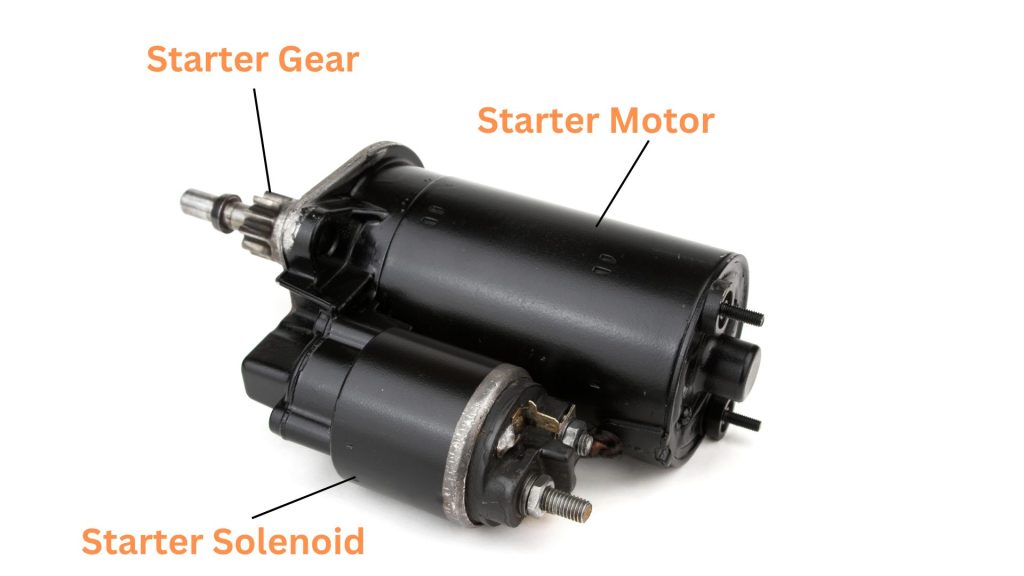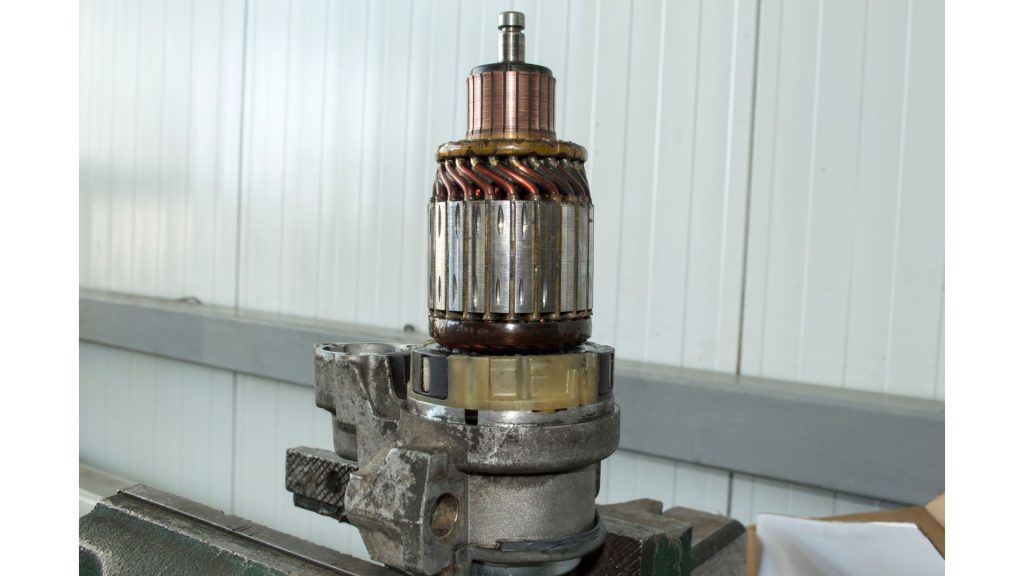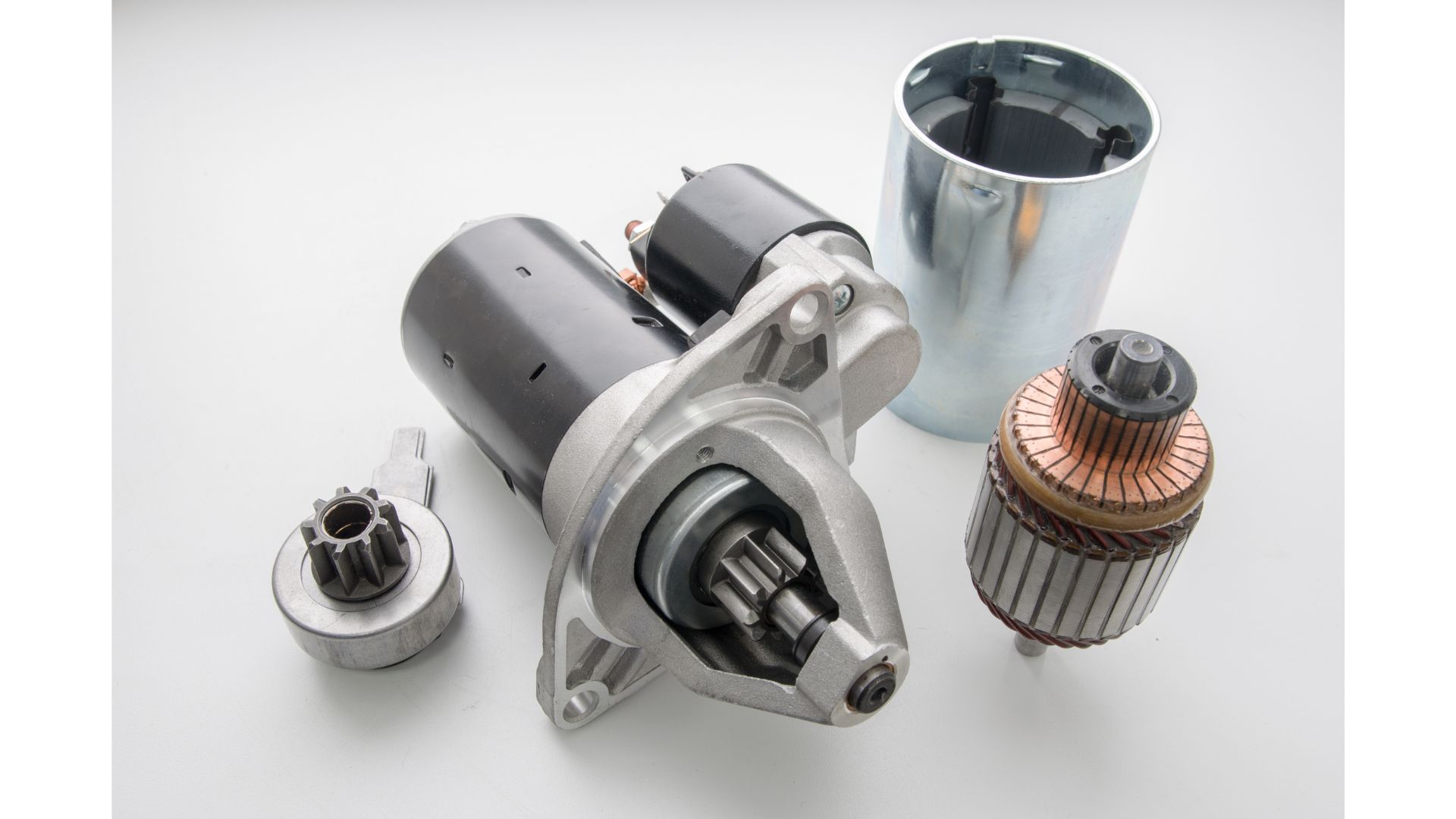Engines rely on each cycle’s inertia to initiate the next cycle. But that only happens in a running engine. How does that first cycle start? What starts the engine to produce the chain reaction that allows your car to run? That responsibility falls on the starter’s shoulders. This is what you need to know about the starter’s work:
1). Where The Starter Came From
If you need a starter motor to start a car today, what did people do before starters came along? Older vehicles had a crank protruding from the hood. You turned it to start the car. Charles Kettering invented the electric starting system, which worked in tandem with an electric motor, generator, and ignition system.
Eventually, Vincent Bendix came along and revolutionalized this mechanism by allowing the starter gears to engage and disengage quickly. The modern starter is sophisticated, constituting the following:

- Armature
This is an electromagnet, a soft iron core encased in conductors and attached to the drive shaft and bearings.
- Brushes
The brushes engage the contacts on the commutator. They conduct electricity.
- Commutator
The commutator, which you find on the rear of the housing, has plates that connect to the electromagnet’s coil.
- Solenoid
The solenoid bridges the starter motor and battery. It has wires that coil around a moveable core.
- Plunger
The plunger uses the battery and solenoid to engage the pinion.
- Lever Fork
The lever fork is connected to the plunger. Therefore, when the plunger moves forward to engage the pinion, the lever fork also moves.
- Pinion
A combination of gears and springs.
- Field Coils
The coils become an electromagnet.
2). What The Starter Does?
The starter has a motor and a solenoid. The solenoid transmits power from the battery to the starter motor. This pushes the drive pinion out, meshing with the flywheel’s gear teeth and sending a charge to the motor, which cranks the engine, starting it.
3). Can A Starter Stop A Car?
No, it can’t. Think about it. What does the starter do? It starts a car. The starter plays a vital but brief role. According to Repair Smith, starter motors and their components should operate for thirty seconds or less. Otherwise, they may overheat.
In other words, starters don’t run a car. They only start the vehicle. And once the car starts running, the starter won’t keep it running. Therefore, even if it failed mid-journey, the vehicle would continue to operate.
It would take a unique series of circumstances, such as a starter falling off the car and disrupting the electrical system, to shut the engine off. Otherwise, this issue shouldn’t concern you.
How Does A Car Starter Go Bad?
Faulty starters are impossible to ignore because they produce noticeable symptoms, such as the following:
1). You Hear Strange Sounds
Some bad starters won’t make any sound before they die. Others will click when you turn the key in the ignition. You also have those that generate whirring and grinding because of worn-out gears or loose and broken components inside the motor.
2). The Car Won’t Start
You can’t always blame a car that won’t start on a bad starter motor. The same thing happens when batteries and alternators die. Keep an eye out for dimming and flickering headlights, warning lights on the dashboard, inaccurate gauges, etc.
You must eliminate the battery and alternator as potential causes before blaming the starter. Don’t expect silence when you turn the key in a vehicle with a bad starter. Some cars will generate a clanking noise because the solenoid or motor is burnt out.
3). Smoke From The Hood
The starter can overheat, creating electrical problems and generating smoke. This can happen because you keep turning the key in a car that refuses to start. Don’t respond to a smoking car by turning the key even harder. This may cause irreversible harm.
4). The Engine Won’t Crank
You have a bad starter motor if you’ve noticed that the starter activates but doesn’t crank the engine.
Sometimes, the results are unpredictable. In other words, the car starts today without issue but refuses to start tomorrow. This is also symptomatic of a bad starter.
5). The Lights Dim When You Start The Car
Starting the car shouldn’t cause the interior and dashboard lights to dim. Dimming lights reveal a short circuit or a fault that keeps pulling power from other places to run the starter.
Problems with the starter have numerous sources. A diagnosis may reveal one or more of the following:
1). Loose/Corroded Connections
Loose or corroded connections can prevent an engine from turning even though the starter motor engages. You will hear the starter’s clunk whenever you turn the key, but the motor won’t start.
2). Broken Gear
Capitol Toyota has highlighted a small gear that engages the flywheel when you turn the key. The teeth of the starting gear can break. Once this happens, the starter can’t engage the engine’s flywheel. You also have situations where the flywheel’s teeth break.
3). Dead Battery
The starter requires large volumes of current from the battery to do its work. Sometimes, a battery has enough juice to run the lights and radio in a car, but the engine refuses to start because the battery’s reserves are not enough to run the starter.
A deficient or depleted battery will prevent the starter from running. This doesn’t mean the starter is damaged.
4). Stuck Solenoid
Don’t drive a car with a stuck solenoid. You know you have a stuck solenoid when the starter stays on.
It is worth noting that some starters are defective from the start. They had a fault when they left the factory. Identify them quickly, and use your warranty to get a replacement.
How Much Does It Cost To Fix Car Starter?

Replacing the starter shouldn’t be your first step. Diagnose the problem and determine whether the faults have viable solutions. For instance:
- Open the hood and check the battery. A bad battery can disrupt the motor. Test the battery and replace it where necessary. Don’t forget to clean corroded terminals. Sometimes, this is enough to solve the problem.
- Check the connections between the starter and the battery. Clean the connections and make sure they are sufficiently tight. Don’t ignore frayed wires. Replace them as opposed to applying electrical tape.
- Disconnect the starter and see if it makes disturbing noises when it isn’t attached to anything. A functional starter will spin freely even when it doesn’t have a load. A questionable response to this test should encourage you to investigate the windings and brushes, especially if the engine refuses to turn even though the starter motor engages.
- Are the bolts loose? If the gears won’t mesh correctly, tighten the bolts.
- Look for bad teeth on the ring gear or starter.
- Look for blown fuses and damaged relays. You should also test the connections between the ignition switch, solenoid, and starter. Is the current flowing?
- Make sure the external connections, plugs, wires, fuses, and relays are secure.
Watch this video to know more in detail!
Ultimately, you may require an expert’s services. First of all, if you can’t find the problem, the mechanic will take the starter apart to locate the fault. Secondly, if you identify the defective components, a mechanic will determine whether you can replace them or if you need a new starter.
A new starter could cost you anywhere between $80 and $350. That figure may exceed $1000 depending on your location, the mechanic’s experience, and the model. You may incur equally exorbitant costs if you ask your mechanic to rebuild the starter.
People choose to rebuild a starter when they can’t find a suitable replacement for their starter. You see this when a car is so old that the manufacturer stopped making replacement parts for that particular model or when an individual lives in an isolated location where new starters are difficult to come by.
Similar challenges can occur if your car is a rare model and you don’t have the money to order a new starter from abroad. Either way, you should leave this decision in the mechanic’s hands.
For all you know, you can fix the starter by gently tapping it to restore power. Naturally, pounding firmly on the starter will cause more harm. You need to tap the device gently.

